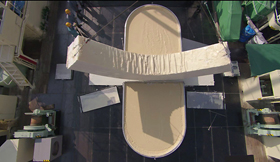Matthew's Blarney

Saturday before Easter was unseasonably warm and sultry. The art troops were out in Chelsea en masse, and in their shirtsleeves. I returned to Gladstone to seek closure in my discussion of Barney. I made a final visit to The Occidental Guest.
One of the displayed sculptures – of masts, pulleys and hawsers seemingly ripped from the deck of a ship and crashed against its railing – made me wonder whether Drawing Restraint 9 ends with a tsunami, a descent into the maelstrom, or some other violent cataclysm of which I was unaware. This would make it a disaster film in the Hollywood mold of The Towering Inferno, and not merely the disaster of towering ego and overblown symbolism that I suggested in my previous posting.
A roomful of drawings depicts various sexually loaded hijinks at sea. A narwhal drills deeply with its tusk. A fleshy hermaphrodite is securely pinioned in bondage, ropes twisting around its breasts and penis. A whale/man penetrates a spread eagled woman. Other schematic drawings try to prepare a theoretical basis for the show. In the center of the room, there is an altar with crossed harpoon and flensing knife, festooned with a garland, and open cans of film beginning to unspool. A fussy parable of fish and film that, like everything else in the show, is rendered in trademark white thermoplastic. Could Moby Dick be far offstage? Hast seen the white whale? Because the white elephant is all too evident.
Near the gallery entrance, a complicated installation with an equally complicated title -- Drawing Restraint 13: The Instrument of Surrender – is typical of Barney’s sequential, jargon laden system of nomenclature. It’s actually the relic of a closed door performance, filmed at the gallery before the show opened to the public. The film is scheduled to be part of future museum shows. Dressed as General Douglas MacArthur, Barney dove into a vat of petroleum jelly, then walked across the floor, leaving a gooey trail, until he reached a worktable equipped with soldering iron, glue gun, roller and other tools (again, all rendered in thermoplastic), where he signed various drawings. The performance, with relic, unconvincingly attempts to conflate two historical moments in US/Japanese relations. MacArthur famously accepted the signed surrender of Emperor Hirohito, to end WWII, aboard a warship; later, as military governor of Japan, he lifted the ban on whale fishing. This conjunction hopes to define something meaningful in Barney’s abstruse, mythopoetic universe. But like many aspects of his cosmology, its presentation seems both over determined and somewhat less than significant.
It’s difficult to view the gallery installation as autonomous sculpture, and not as a display of (reconstructed) sets, props, and other scenic outtakes from the DR films, on which it depends so heavily for context and meaning. Which is too bad, because the sculptures are not without a formal, plastic, expressive value, at least partly due to the way they use their Arte Povera/Post Minimal materiality. Ultimately, Barney might not be doing himself any favors by burdening his sculpture with heavy conceptual underpinnings, which tend to drag them down into the murk. They might signify better without any Restraint, as it were, being given a chance to resonate on their own terms. But Barney prefers a total effort, a Gesamtkunstwerk, tethering his sculpture to films that vacillate between the ludicrous and the pretentious, with an occasional side trip to the unwatchable. His need to fashion an epic persona, to place himself at the iconic center of his work, to perform, to be a recognizable star – it suffers from hubris. But then, that’s show biz.


